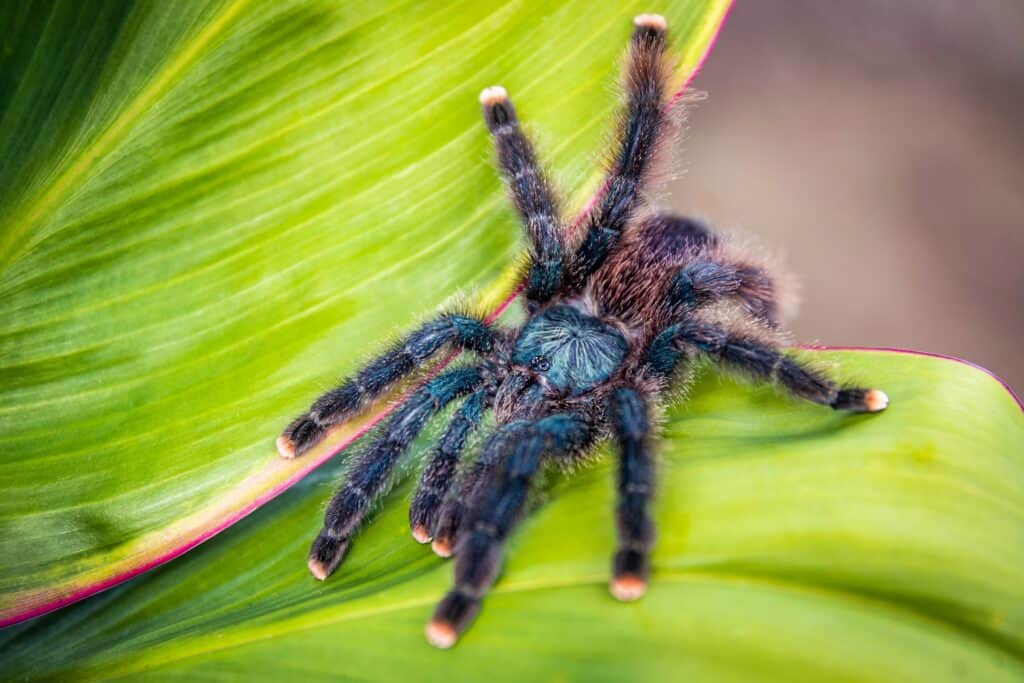Pink Toed Tarantula
Avicularia avicularia
Can jump short distances
Advertisement
Pink Toed Tarantula Scientific Classification
- Kingdom
- Animalia
- Phylum
- Arthropoda
- Class
- Arachnida
- Order
- Araneae
- Family
- Theraphosidae
- Genus
- Avicularia
- Scientific Name
- Avicularia avicularia
Read our Complete Guide to Classification of Animals.
Pink Toed Tarantula Conservation Status
Pink Toed Tarantula Facts
- Prey
- Insects, tree frogs, lizards
- Name Of Young
- Spiderlings
- Group Behavior
- Solitary
- Fun Fact
- Can jump short distances
- Estimated Population Size
- Millions
- Biggest Threat
- Predators
- Most Distinctive Feature
- Pink toes
View all of the Pink Toed Tarantula images!
Summary
Known for its distinctive pink feet, the pink toe tarantula is a New World tarantula in the family Theraphosidae. The pink toe tarantula ranges throughout northern South America and some islands in the Caribbean. An arboreal species, it relies on several methods to capture prey, including hunting, foraging, and employing ambush tactics. It possesses relatively mild venom compared to other New World tarantulas and uricating hairs that it uses to defend itself. In recent years, the pink toe tarantula has grown increasingly popular amongst exotic pet owners.
5 Pink Toe Tarantula Facts
- Pink toe tarantulas are arboreal spiders that ambush their prey using spun silk traps.
- Unlike most tarantulas, the pink toe tarantula can jump for small distances of up 3 or 4 centimeters.
- While female pink toe tarantulas can live between 6 and 9 years, males typically only live 2 to 3 years.
- When threatened, pink toe tarantulas may propel feces toward an attacker, assume a defensive posture, or bite.
- Female pink toe tarantulas measure slightly larger than males and occasionally engage in sexual cannibalism.
Pink Toed Tarantula Scientific Name
The pink toe tarantula also goes by the name the Guyana pink toe or the South American pink toe. It belongs to the family Theraphosidae and is the type species of the genus Avicularia. Its genus name, Avicularia, derives from the Latin words avicula, meaning “little bird,” and the suffix –aria, from the Latin -arius, meaning “pertaining to.” Taken together, species within the genus are often referred to as “bird spiders” or “bird-eating spiders.”
Pink Toe Tarantula Appearance

When threatened, pink toe tarantulas may propel feces toward an attacker, assume a defensive posture, or bite.
©Photo Spirit/Shutterstock.com
Like most spiders, pink toe tarantulas display sexual dimorphism, with females measuring slightly larger than males. On average, females sport a leg span of around 4.75 inches, while males measure around 3.5 inches. However, the largest specimens can measure up to 6 inches from end to end. They sport eight legs, two grasping appendages called pedipalps, and a pair of large, venomous fangs known as chelicerae.
As juveniles, pink toe tarantulas appear mostly pinkish aside from their dark-colored feet. Around the time they reach adulthood, their color switches, and the body turns dark while the feet look pink. The hairs on an adult’s body appear predominantly dark brown or black but sometimes feature a green, iridescent sheen.
Pink Toe Tarantula Behavior
Generally speaking, pink toe tarantulas are solitary creatures. While they may occasionally live in proximity to one another, this raises the likelihood of them cannibalizing one another. Pink toe tarantulas are arboreal, living most of their lives in trees. Like other tarantulas, they sleep during the day and emerge at night to hunt and forage for food. When threatened, they may assume a defensive posture or propel feces toward a threat. Although they possess uricating hairs, they can not kick them like other New World tarantulas. However, unlike many tarantulas, they can leap short distances, particularly as juveniles. They primarily leap when startled or to escape predators.
Pink Toe Tarantula Habitat
The pink toe tarantula is an arboreal species that spends most of its life on the ground in trees. They live primarily in grasslands and temperate and tropical forests. Pink toe tarantulas construct nests and tunnels, sometimes collecting nearby debris to build these structures. When kept in captivity, they require tall glass enclosures with plenty of features to climb. Their enclosures should contain dry substrate and fresh water to provide adequate humidity and ventilation. Without proper ventilation, humidity can cause stagnant air and bacterial growth that may prove fatal.
Pink Toe Tarantula Diet
Like all tarantulas, pink toe tarantulas are carnivores. Their diet primarily consists of insects such as crickets, grasshoppers, moths, and beetles. That said, they will eat pretty much anything that they can catch. This includes small tree frogs and lizards, although vertebrates generally make up a small portion of their diet.
Pink toe tarantulas hunt using silk traps that they use to sense their prey. They emerge from their burrows at night to hunt and forage, typically relying on ambush tactics and stealth. Their venom can subdue small prey, although it poses little threat to humans. At worst, their bite may cause some mild pain, irritation, or swelling.
Pink Toe Tarantula Predators and Threats
The largest threat that pink toe tarantulas face comes from predators. Some common predators of the pink toe tarantula include large lizards, frogs, and birds. In addition, pink toe tarantulas must contend with competition and predation by other tarantulas. Predation commonly occurs when mature tarantulas eat juveniles, or when females cannibalize males before or after mating.
The other threat to pink toe tarantulas comes from human activity. In recent years, they have become increasingly targeted by the pet trade. Due to their moderate levels of aggression and interesting appearance, they make popular pets. However, this increased targeting does not appear to have severely affected their population or distribution at this time.
Pink Toe Tarantula Reproduction and Life Cycle
Generally speaking, pink toe tarantulas typically breed around once a year. Females are more receptive to mate when well-fed and may cannibalize males if hungry. Moreover, females typically only mate if they have molted within the last 6 months. Mating can take anywhere from a few minutes to a few hours. During mating, the male will hold onto the female with his pedipalps.
Like most other spiders, pink toe tarantulas lay eggs. The eggs gestate for around 7 weeks before the spiderlings hatch. As juveniles, pink toe tarantulas look primarily pink and feature dark-colored toes. They must go through several molts, wherein they shed their exoskeleton before they eventually develop the characteristic dark-colored body and pink toes of a mature adult.
On average, female pink toe tarantulas live around 6 to 9 years, while males live only 2 to 3 years. However, some specimens can live up to 10 years in captivity given the right conditions.
Pink Toe Tarantula Population
Pink toe tarantulas are increasingly common in their native range that covers much of northern South America and several Caribbean islands. Despite threats from predators and increased targeting from the pet trade their population appears stable. It’s difficult to know for certain how many pink toe tarantulas exist in the wild or as pets in captivity. However, it’s safe to estimate that thousands live in captivity while millions live in the wild.
Pink Toe Tarantula Locations
As their family nickname (New World) suggests, pink toe tarantulas throughout South America and the Caribbean. You can find them in Venezuela, Peru, Bolivia, and Brazil. They tend to live in grasslands and temperate or tropical forests. As an arboreal species, they require access to trees and freshwater.
Pink Toe Tarantula Conservation Status
Given their widespread distribution, pink toe tarantulas do not face any immediate threats to their conservation. At this time, they are Not Evaluated by the IUCN or protected by any international regulations. Despite increasing targeted by the pet trade, their population remains stable in most areas and shows no signs of decline.
Similar Animals
View all 192 animals that start with PPink Toed Tarantula FAQs (Frequently Asked Questions)
Are pink toe tarantulas carnivores, herbivores, or omnivores?
Like all tarantulas, pink toe tarantulas are carnivorous predators. They are nocturnal hunters that target a wide variety of prey, including insects, small tree frogs, and lizards.
How venomous is a pink toe tarantula?
Pink toe tarantulas produce venom like all tarantulas. However, compared to other New World tarantulas, their venom is rather mild and poses no danger to humans. At worst, their venom causes some mild pain, redness, and swelling.
Are pink toe tarantulas friendly?
Pink toe tarantulas make popular pets among new and experienced owners due to their relatively calm personality. They are relatively docile and shy and aren’t prone to act overly aggressive.
Can you handle a pink toe tarantula?
As long as you handle them gently, you can pick up a pink toe tarantula. That said, they don’t like quick movements and are not considered cuddly animals.
Thank you for reading! Have some feedback for us? Contact the AZ Animals editorial team.
















